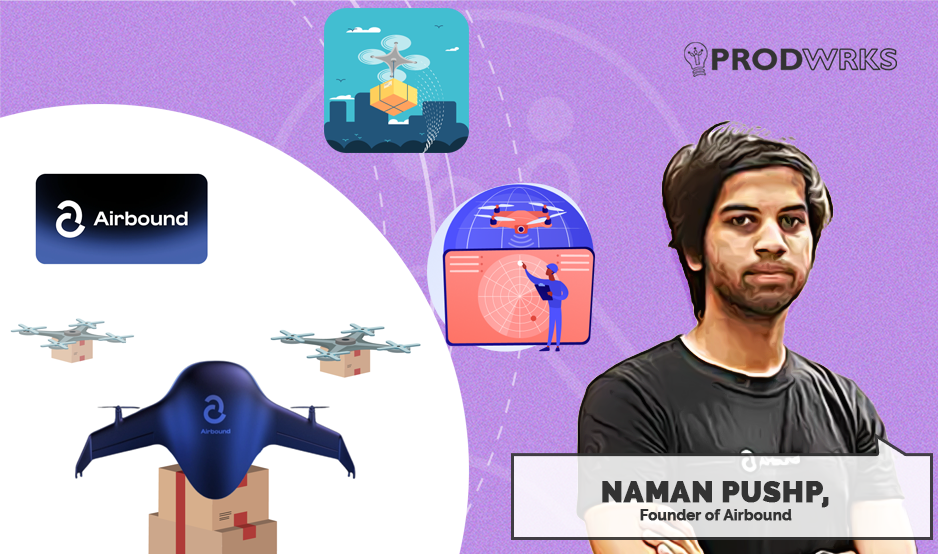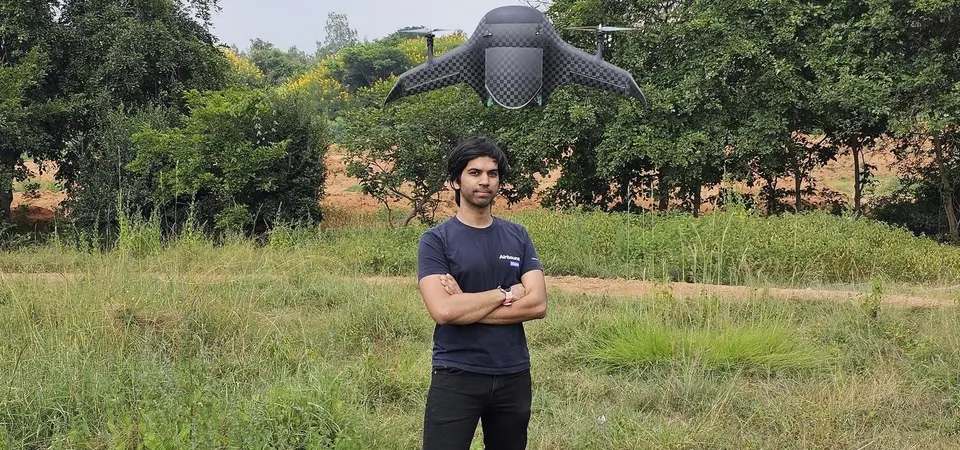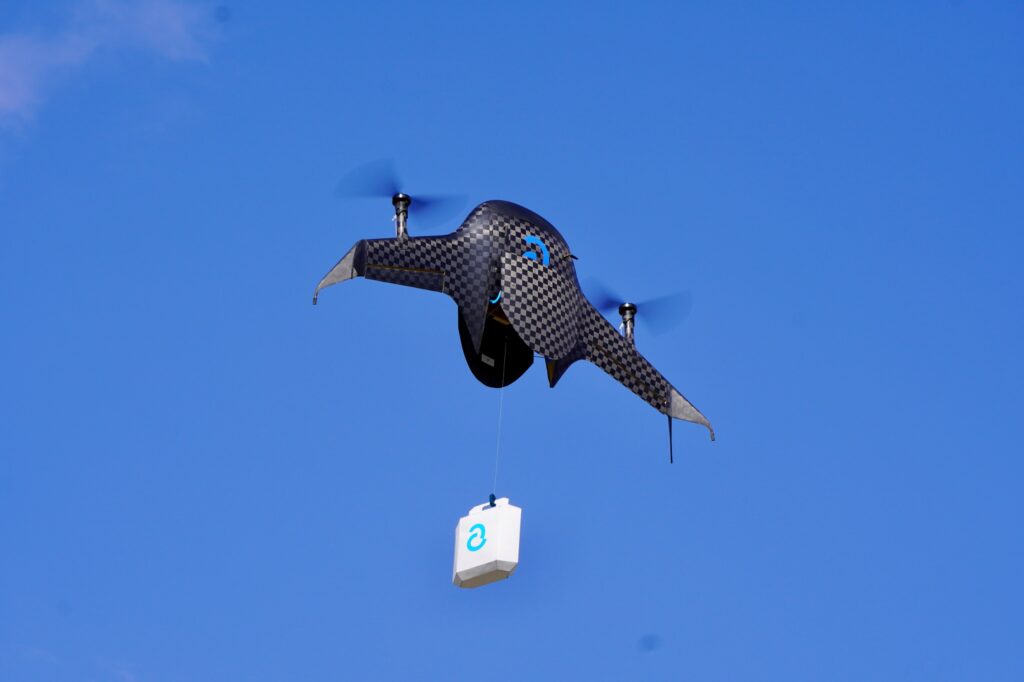
What if moving a package across a city costs less than the electricity to power a lightbulb for an hour? What if the physical movement of goods, from life-saving blood samples to your evening meal, could become so frictionless, so cheap, that it fundamentally reshaped our cities, our economies, and our lives?
This is the foundational question driving 20-year-old Naman Pushp, the founder of Airbound, a drone technology startup with an ambition so vast it borders on audacious. But Naman is clear that to make drone delivery a reality, we must focus on achieving low-cost delivery economics that make drone adoption a no-brainer.
In a candid conversation with the ProdWrks team, Naman points out that the drone delivery industry, as it exists today, is largely a facade.
Naman says, “If you look at drone delivery companies in India today, at most 30% of their deliveries happen via drone. The rest are just happening with an on-ground fleet. Most ventures are basically a glorified logistics company using the PR of drones to justify their existence.”
The numbers tell a stark story. A typical last-mile delivery by a human on a scooter costs around ₹10 per kilometre. Today’s drone delivery services? A staggering ₹100 per kilometre. It’s a model, Naman asserts, that “economically does not work and is not capable of scaling.”

This is the central problem Airbound was born to solve. While others are iterating on a broken model, Airbound has gone back to the drawing board, armed with obsessive engineering and a ruthless focus on first-principle physics. Their goal is not to be 10% better. It is to be 100 times better, to drive the cost of delivery down to a mind-bending 30 paise per kilometre!
If they succeed, they won’t just be a drone company. They will be the architects of a logistics revolution, a change as profound as the Internet was for information.
The Engineer’s Addiction
To understand Airbound, one must first understand Naman Pushp. While his peers might have been drawn to the immediate gratification of software and coding, Naman found his calling in the gruelling, tangible world of hardware and robotics.
This love for the “grind” of hardware, for the physical intervention required to bend the world to engineering will, is the cultural bedrock of Airbound. It’s a culture born from a founder who, in the early days with robotics in school, was hand-cutting foam stencils and joining them with toothpicks because he couldn’t afford a 3D printer. It’s this background that informs Airbound’s rejection of the prevailing “black box” mentality in the drone industry.
“The drone sector does an excellent job of making talent bad,” Naman says, offering a sharp critique. “It has bred a culture where people treat these things like black boxes, and engineering is done based on intuition and rules of thumb rather than proper analytical understanding. It's very hard to build a serious drone company if it's being built on top of hobbyist culture.”
Airbound, therefore, is the antithesis of a hobbyist-driven company. It is a temple of analytical rigour, a place where every gram matters, and every decision is interrogated against the unforgiving laws of physics and economics.
Deconstructing the Cost
“The point that I give to my team is that the benchmark cost of an average last-mile delivery today (for the Swiggy’s and Zomatos of the world) is 10 rupees per kilometre. If it’s electric, it is two rupees per kilometre. This is essentially the cost of moving 150 kgs of mass from point A to point B. It’s the vehicle plus the passenger, plus the payload,” Naman explains, referring to the operational cost of a standard electric scooter used for delivery.
“If I can bring the whole thing down to about five kgs that I'm moving… well, I've reduced the weight by over an order of magnitude. My cost would absolutely be going down by over an order of magnitude,” he reasons.
This is the first principle: mass dictates cost.
The current drone paradigm fails because it moves too much of it. Bloated, inefficient designs require massive, expensive batteries. These Lithium Polymer (LiPo) batteries, Naman points out, are the financial Achilles’ heel of the drone industry.
“LiPos last 100 to 200 cycles at best. The cost of battery replacement alone ends up being more than 30 to 40 rupees per kilometer.”
Airbound’s entire design philosophy is an attack on this inefficiency. It’s a mission of radical weight reduction. It’s a crusade against every unnecessary gram. Their website proudly proclaims this “obsessive engineering”:
“We reject parts for being 3g overweight, develop entirely new manufacturing processes to shave less than 5g off of parts, and built a custom power delivery module to reduce wire weight by 12g.”

Decoding the Efficiency of the Airbound Drone
1. Blended Wing Body (BWB): Inspired by advanced concepts from giants like Boeing, the BWB design seamlessly merges the wing and the fuselage. This creates a single, continuous lifting surface. The aerodynamic benefit is a phenomenal lift-to-drag ratio. The lift is distributed evenly across the entire frame, minimizing bending forces and reducing the need for heavy internal supports. This, combined with a meticulously engineered carbon fiber frame, creates a structure that Airbound claims is 10 times lighter than other long-range delivery drones.
2. Tailsitter VTOL: According to their website, the aircraft “takes off like a rocket, and flies like a plane.” This is the magic of their tail-sitter Vertical Take-Off and Landing (VTOL) design. Let me break it down. Instead of having separate sets of propellers for vertical lift and horizontal flight, the tailsitter uses the same propulsion system for both. It points its nose to the sky to take off and land vertically, then rotates its entire body to fly horizontally like a conventional aircraft. This eliminates redundant components, making it inherently lighter and more efficient.
The design innovation helps Airbound drone to restrict its (empty) weight to 1.5 kg, with a current cargo carrying capacity of 1kg. It’s claimed top speed is an impressive 100 km/hr, with a range of 37kms.
To put this simply, Airbound has condensed the capability of a 15-25 kg drone into an aircraft that weighs a mere 1500 grams. It’s a complete redefinition of what a delivery drone can be. The manufacturing cost, cited at around $700 (potential to reduce drastically with scale), makes the unit economics of a large-scale delivery network plausible.
Engineering-Led Innovation, Not Market-Driven
In a world where product managers are taught to live and breathe for the customer, Naman offers a different perspective. He doesn’t think about the product as being in service of the customer. “It’s almost that the customer is in service of the product,” he says.
For Airbound, it makes perfect sense. “We have this vision of what the future will look like 20 years down the line. The way you pick your customer is largely just, who will get me there fastest? Who will get me to this product? Not what product will get me to this customer.”
This means that Airbound’s product roadmap isn’t dictated by a client’s request for a new dashboard feature or any UI. It’s dictated by the relentless pursuit of hardware efficiency. Iterations are driven by questions like: “How can we improve aerodynamic stability?” or “Can this carbon fiber process make the part even lighter?”
The real software engineering in Airbound is also invisible: the control algorithms that keep the drone stable in gusty winds, the sensor fusion that builds a picture of the world, the layers of autonomy and fail-safes that ensure reliability. “It doesn’t matter if I can manage a fleet of 1000 drones if it’s not even economically viable for me to do delivery with one drone,” says Naman.
The business model reflects this product-centric approach. Being a drone company, Airbound is not in the business of selling drones. Naman says, “It’s a very complex system. It’s not something that you can just hand over to someone and expect them to be able to operate.”
Instead, they offer a full-stack, delivery-as-a-service platform. They own the hardware, the software, the operations, and the complexity. Customers simply pay on a per-delivery basis. This aligns incentives perfectly. The cheaper Airbound can make each delivery, the more compelling their service becomes, and the wider their margin.
Scaling and GTM
“I want to be making lakhs of drones per day. And frankly, right now in India, not a lot of people are even making one drone per day,” he admits.
Naman says, “This doesn't work if your drone crashes after 100 flights. It doesn't matter if I can manage a fleet of 1000 drones if it's not even economically viable for me to do delivery with one drone. I can only manage a fleet of 1000s of drones if these drones can last 10s of 1000s of hours. Each one of them.”
They are working on control algorithms that keep the drone stable in gusty winds, the sensor fusion that builds a picture of the world, and the layers of autonomy and fail-safes that ensure reliability.
Currently, Airbound sees a huge potential for its drones in the healthcare space. Healthcare in India is a market that deeply values speed, reliability, and is favourable from a regulatory standpoint. A powerful early use case is blood sample delivery. Naman shared that he is piloting with a “big” healthcare client, without disclosing the name.
“If you look at the cost of doing blood tests, most of the cost is actually in the logistics,” Naman explains. By enabling rapid, cheap transport from clinics to centralised, high-throughput labs, Airbound can dramatically drive down healthcare costs. This is as much about efficiency as it is about enabling a complete restructuring of the diagnostics industry!
A Ten Trillion Dollar Future
“For instance, 60% of India doesn't have access to a fridge. I want to create a world or a reality where those people never need access to a fridge anymore. If you can just order anything perishable twice a day and just consume as you go, with a delivery cost of just two rupees per day. That is significantly cheaper than even the electricity cost of a fridge.”
Naman wants to “create a world where the movement of goods and people is almost as accessible as the movement of information.”
He speaks of a world where surgical instruments can be flown to a central sterilization facility between operations, or where a commute from one end of Bangalore to the other takes 30 minutes via autonomous drones and costs less than an auto-rickshaw. This is not a service for just the wealthy. It’s a fundamental infrastructure for everyone.
He says, “What we're fundamentally doing is we're creating cost arbitrage. We are creating a new technology that is just able to do things so unbelievably efficiently that it allows you to do crazy things that just did not make sense earlier.”



